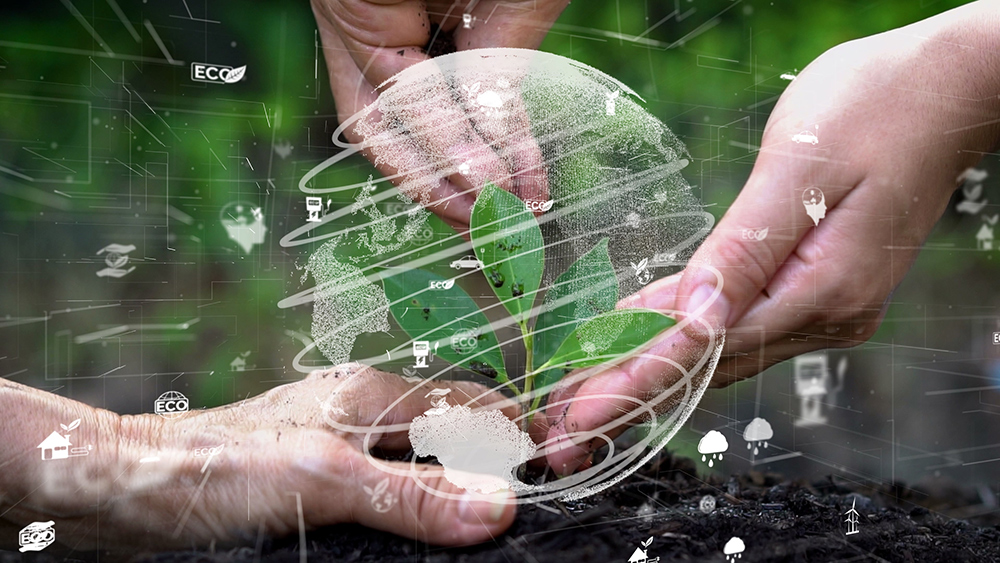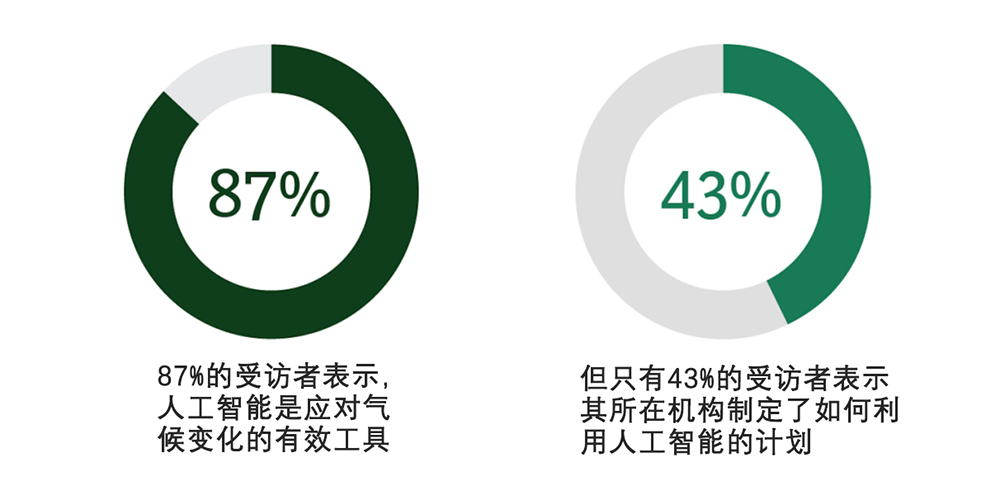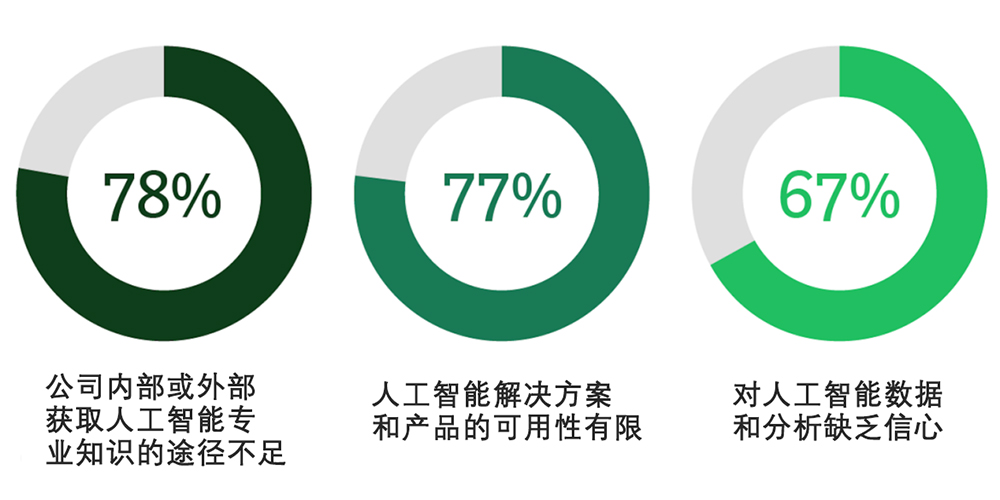
在你的公司,每天或許會(huì)做出數(shù)百個(gè)決策,,可能提高或降低公司的可持續(xù)性,。我們應(yīng)該選擇哪一家供應(yīng)商?我們的產(chǎn)品應(yīng)該采購(gòu)綠色玻璃還是透明玻璃,?我們應(yīng)該在倫敦還是紐約舉辦會(huì)議,?
人工智能能夠幫助企業(yè)完善決策,從而優(yōu)化財(cái)務(wù)業(yè)績(jī),、改進(jìn)流程,、滿足客戶需求等。它對(duì)于企業(yè)實(shí)現(xiàn)氣候目標(biāo)同樣關(guān)鍵,。事實(shí)上,,人工智能可以收集、整理和解讀龐大復(fù)雜的碳排放和氣候影響數(shù)據(jù)集,,因此它對(duì)于管理全部氣候相關(guān)問(wèn)題至關(guān)重要,。
波士頓咨詢公司(BCG)最近對(duì)全球1,000位人工智能和氣候領(lǐng)域的領(lǐng)導(dǎo)者進(jìn)行了調(diào)查,向我們展現(xiàn)了人工智能在這方面的潛力,,以及在應(yīng)用人工智能過(guò)程中所面臨的障礙,。我們發(fā)現(xiàn),有87%的受訪者感覺(jué)高級(jí)分析和人工智能或者單純的“人工智能”,,是目前應(yīng)對(duì)氣候變化的有效工具,,但只有43%的受訪者表示計(jì)劃利用人工智能幫助公司應(yīng)對(duì)氣候變化。

他們認(rèn)為人工智能在減少和測(cè)算排放方面具有最大的商業(yè)價(jià)值,。事實(shí)上,全球領(lǐng)導(dǎo)者能夠通過(guò)各種方式利用人工智能實(shí)現(xiàn)他們的氣候目標(biāo):
減排,。人工智能可以幫助測(cè)算宏觀和微觀層面的排放,,減少排放的影響,并從大氣中清除現(xiàn)有排放,。我們?cè)诠ぷ髦邪l(fā)現(xiàn),,人工智能能夠?qū)⒁患移髽I(yè)的碳足跡減少5%至10%,如果擴(kuò)大到全球,,減少的溫室氣體排放量就相當(dāng)于26億噸至53億噸二氧化碳當(dāng)量,。
有一些令人激動(dòng)的例子可以證明人工智能已經(jīng)在這方面發(fā)揮作用。由阿爾·戈?duì)柾顿Y的氣候跟蹤(跟蹤實(shí)時(shí)大氣碳排放)(Climate TRACE)聯(lián)盟利用衛(wèi)星圖像和人工智能測(cè)算排放量,。其成員Blue Sky Analytics能夠?qū)iT(mén)估算火災(zāi)產(chǎn)生的排放量,。Pachama利用衛(wèi)星圖像和人工智能測(cè)算和監(jiān)控森林碳匯的變化,以此確定高質(zhì)量碳信用額度,。
波士頓咨詢公司的二氧化碳人工智能平臺(tái)可以幫助大規(guī)模測(cè)算,、模擬、跟蹤和優(yōu)化機(jī)構(gòu)的碳排放,。這款可即時(shí)部署的軟件能夠在所有工業(yè)部門(mén)廣泛應(yīng)用,,包括石油天然氣、生物制藥,、汽車(chē)和消費(fèi)品等領(lǐng)域,。它不僅可以準(zhǔn)確測(cè)算公司自營(yíng)業(yè)務(wù)的直接排放量(范圍一和范圍二排放),還能夠測(cè)算公司整個(gè)價(jià)值鏈產(chǎn)生的更難測(cè)算的間接排放(范圍三排放),。
適應(yīng)性和氣候應(yīng)變能力,。人工智能還適合幫助預(yù)測(cè)氣候相關(guān)危害,包括改善對(duì)局部事件的長(zhǎng)期預(yù)測(cè),,比如海平面上升等,或者更新對(duì)颶風(fēng)或干旱等極端現(xiàn)象的預(yù)警系統(tǒng),。例如,,東南亞地區(qū)的一個(gè)項(xiàng)目就展示了人工智能和高級(jí)分析如何幫助當(dāng)?shù)厣鐓^(qū)適應(yīng)氣候變化。該項(xiàng)目團(tuán)隊(duì)將衛(wèi)星數(shù)據(jù)與高級(jí)洪水模擬相結(jié)合,,可以識(shí)別醫(yī)院等關(guān)鍵基礎(chǔ)設(shè)施以及最容易暴發(fā)洪水的濕地等,,從而了解在哪些戰(zhàn)略位置安放人工屏障能夠發(fā)揮最大效果。
人工智能也可以幫助管理漏洞和風(fēng)險(xiǎn),,監(jiān)控當(dāng)前危機(jī),,強(qiáng)化基礎(chǔ)設(shè)施(比如通過(guò)智能灌溉),通過(guò)預(yù)測(cè)大規(guī)模遷徙模式保護(hù)人類(lèi),,以及通過(guò)識(shí)別和統(tǒng)計(jì)物種數(shù)量保護(hù)生物多樣性等,。
研究,、金融和教育。人工智能還能夠作為支持氣候研究和模擬的有效工具,,幫助了解氣候變化的規(guī)模,,并為政策決策提供參考。人工智能可以預(yù)測(cè)碳價(jià)格,,在氣候金融方面發(fā)揮著關(guān)鍵作用,。人工智能還能夠通過(guò)個(gè)性化的工具幫助教育公眾,影響行為,,例如預(yù)測(cè)個(gè)人碳足跡,,或者推薦購(gòu)買(mǎi)氣候友好的商品等。無(wú)論是減排還是適應(yīng)氣候變化,,或者提升氣候應(yīng)變能力,,投資這些人工智能驅(qū)動(dòng)的基礎(chǔ)領(lǐng)域?qū)⑹浅晒Φ年P(guān)鍵。
克服人工智能應(yīng)用的障礙
既然強(qiáng)大的人工智能有這么多機(jī)會(huì)在應(yīng)對(duì)氣候變化方面發(fā)揮作用,,到底是什么讓企業(yè)遲遲不愿意擴(kuò)大人工智能的應(yīng)用范圍呢,?在有些領(lǐng)域,人工智能解決方案已經(jīng)非常成熟,,可以進(jìn)行廣泛應(yīng)用,,但大多數(shù)現(xiàn)有解決方案不成體系,可能難以獲得,,并且缺少擴(kuò)大規(guī)模的資源,。有78%的受訪者表示,應(yīng)用人工智能的障礙源于沒(méi)有充分的人工智能專(zhuān)業(yè)知識(shí),,77%的受訪者提到了有限可用性,,而有67%的受訪者則是由于對(duì)人工智能相關(guān)數(shù)據(jù)和分析缺乏信心。

人工智能并非萬(wàn)能靈藥。它只是我們用來(lái)應(yīng)對(duì)氣候變化這項(xiàng)全球挑戰(zhàn)的諸多工具之一,。但它能夠幫助我們選擇一條更明智,、日益以數(shù)據(jù)驅(qū)動(dòng)的和更快速的道路,而且我們沒(méi)有時(shí)間可以浪費(fèi),。(財(cái)富中文網(wǎng))
本文作者克里斯托夫·施偉策(Christoph Schweizer)現(xiàn)任波士頓咨詢公司全球首席執(zhí)行官,。波士頓咨詢公司是《財(cái)富》雜志“零排放路徑”(Path to Zero)項(xiàng)目的合作伙伴。
譯者:劉進(jìn)龍
審校:汪皓
在你的公司,,每天或許會(huì)做出數(shù)百個(gè)決策,,可能提高或降低公司的可持續(xù)性。我們應(yīng)該選擇哪一家供應(yīng)商,?我們的產(chǎn)品應(yīng)該采購(gòu)綠色玻璃還是透明玻璃,?我們應(yīng)該在倫敦還是紐約舉辦會(huì)議,?
人工智能能夠幫助企業(yè)完善決策,從而優(yōu)化財(cái)務(wù)業(yè)績(jī),、改進(jìn)流程,、滿足客戶需求等。它對(duì)于企業(yè)實(shí)現(xiàn)氣候目標(biāo)同樣關(guān)鍵,。事實(shí)上,,人工智能可以收集、整理和解讀龐大復(fù)雜的碳排放和氣候影響數(shù)據(jù)集,,因此它對(duì)于管理全部氣候相關(guān)問(wèn)題至關(guān)重要,。
波士頓咨詢公司(BCG)最近對(duì)全球1,000位人工智能和氣候領(lǐng)域的領(lǐng)導(dǎo)者進(jìn)行了調(diào)查,向我們展現(xiàn)了人工智能在這方面的潛力,,以及在應(yīng)用人工智能過(guò)程中所面臨的障礙,。我們發(fā)現(xiàn),有87%的受訪者感覺(jué)高級(jí)分析和人工智能或者單純的“人工智能”,,是目前應(yīng)對(duì)氣候變化的有效工具,,但只有43%的受訪者表示計(jì)劃利用人工智能幫助公司應(yīng)對(duì)氣候變化。
他們認(rèn)為人工智能在減少和測(cè)算排放方面具有最大的商業(yè)價(jià)值,。事實(shí)上,,全球領(lǐng)導(dǎo)者能夠通過(guò)各種方式利用人工智能實(shí)現(xiàn)他們的氣候目標(biāo):
減排。人工智能可以幫助測(cè)算宏觀和微觀層面的排放,,減少排放的影響,,并從大氣中清除現(xiàn)有排放。我們?cè)诠ぷ髦邪l(fā)現(xiàn),,人工智能能夠?qū)⒁患移髽I(yè)的碳足跡減少5%至10%,,如果擴(kuò)大到全球,減少的溫室氣體排放量就相當(dāng)于26億噸至53億噸二氧化碳當(dāng)量,。
有一些令人激動(dòng)的例子可以證明人工智能已經(jīng)在這方面發(fā)揮作用,。由阿爾·戈?duì)柾顿Y的氣候跟蹤(跟蹤實(shí)時(shí)大氣碳排放)(Climate TRACE)聯(lián)盟利用衛(wèi)星圖像和人工智能測(cè)算排放量。其成員Blue Sky Analytics能夠?qū)iT(mén)估算火災(zāi)產(chǎn)生的排放量,。Pachama利用衛(wèi)星圖像和人工智能測(cè)算和監(jiān)控森林碳匯的變化,,以此確定高質(zhì)量碳信用額度。
波士頓咨詢公司的二氧化碳人工智能平臺(tái)可以幫助大規(guī)模測(cè)算,、模擬,、跟蹤和優(yōu)化機(jī)構(gòu)的碳排放,。這款可即時(shí)部署的軟件能夠在所有工業(yè)部門(mén)廣泛應(yīng)用,,包括石油天然氣、生物制藥,、汽車(chē)和消費(fèi)品等領(lǐng)域,。它不僅可以準(zhǔn)確測(cè)算公司自營(yíng)業(yè)務(wù)的直接排放量(范圍一和范圍二排放),,還能夠測(cè)算公司整個(gè)價(jià)值鏈產(chǎn)生的更難測(cè)算的間接排放(范圍三排放)。
適應(yīng)性和氣候應(yīng)變能力,。人工智能還適合幫助預(yù)測(cè)氣候相關(guān)危害,,包括改善對(duì)局部事件的長(zhǎng)期預(yù)測(cè),比如海平面上升等,,或者更新對(duì)颶風(fēng)或干旱等極端現(xiàn)象的預(yù)警系統(tǒng),。例如,東南亞地區(qū)的一個(gè)項(xiàng)目就展示了人工智能和高級(jí)分析如何幫助當(dāng)?shù)厣鐓^(qū)適應(yīng)氣候變化,。該項(xiàng)目團(tuán)隊(duì)將衛(wèi)星數(shù)據(jù)與高級(jí)洪水模擬相結(jié)合,,可以識(shí)別醫(yī)院等關(guān)鍵基礎(chǔ)設(shè)施以及最容易暴發(fā)洪水的濕地等,從而了解在哪些戰(zhàn)略位置安放人工屏障能夠發(fā)揮最大效果,。
人工智能也可以幫助管理漏洞和風(fēng)險(xiǎn),,監(jiān)控當(dāng)前危機(jī),強(qiáng)化基礎(chǔ)設(shè)施(比如通過(guò)智能灌溉),,通過(guò)預(yù)測(cè)大規(guī)模遷徙模式保護(hù)人類(lèi),,以及通過(guò)識(shí)別和統(tǒng)計(jì)物種數(shù)量保護(hù)生物多樣性等。
研究,、金融和教育,。人工智能還能夠作為支持氣候研究和模擬的有效工具,幫助了解氣候變化的規(guī)模,,并為政策決策提供參考,。人工智能可以預(yù)測(cè)碳價(jià)格,在氣候金融方面發(fā)揮著關(guān)鍵作用,。人工智能還能夠通過(guò)個(gè)性化的工具幫助教育公眾,,影響行為,例如預(yù)測(cè)個(gè)人碳足跡,,或者推薦購(gòu)買(mǎi)氣候友好的商品等,。無(wú)論是減排還是適應(yīng)氣候變化,或者提升氣候應(yīng)變能力,,投資這些人工智能驅(qū)動(dòng)的基礎(chǔ)領(lǐng)域?qū)⑹浅晒Φ年P(guān)鍵,。
克服人工智能應(yīng)用的障礙
既然強(qiáng)大的人工智能有這么多機(jī)會(huì)在應(yīng)對(duì)氣候變化方面發(fā)揮作用,到底是什么讓企業(yè)遲遲不愿意擴(kuò)大人工智能的應(yīng)用范圍呢,?在有些領(lǐng)域,,人工智能解決方案已經(jīng)非常成熟,可以進(jìn)行廣泛應(yīng)用,,但大多數(shù)現(xiàn)有解決方案不成體系,,可能難以獲得,并且缺少擴(kuò)大規(guī)模的資源。有78%的受訪者表示,,應(yīng)用人工智能的障礙源于沒(méi)有充分的人工智能專(zhuān)業(yè)知識(shí),,77%的受訪者提到了有限可用性,而有67%的受訪者則是由于對(duì)人工智能相關(guān)數(shù)據(jù)和分析缺乏信心,。
人工智能并非萬(wàn)能靈藥,。它只是我們用來(lái)應(yīng)對(duì)氣候變化這項(xiàng)全球挑戰(zhàn)的諸多工具之一。但它能夠幫助我們選擇一條更明智,、日益以數(shù)據(jù)驅(qū)動(dòng)的和更快速的道路,,而且我們沒(méi)有時(shí)間可以浪費(fèi)。(財(cái)富中文網(wǎng))
本文作者克里斯托夫·施偉策(Christoph Schweizer)現(xiàn)任波士頓咨詢公司全球首席執(zhí)行官,。波士頓咨詢公司是《財(cái)富》雜志“零排放路徑”(Path to Zero)項(xiàng)目的合作伙伴,。
譯者:劉進(jìn)龍
審校:汪皓
Every day, people throughout your organization make decisions—possibly hundreds of them—that either increase or decrease its sustainability. Which supplier should we choose? Do we procure green glass or clear glass for our product? Should we host the conference in London or New York?
Just as artificial intelligence has improved the decisions organizations make to optimize financial performance, improve processes, meet customer needs, and more, it will be critical in helping them reach their climate goals. In fact, because it can gather, complete, and interpret large, complex datasets on emissions and climate impact, A.I. is fundamentally important in helping to manage the full range of climate-related issues.
BCG recently conducted a global survey of 1,000 leaders in A.I. and climate that tells us more about that potential—as well as the barriers getting in the way. We found that 87% of respondents feel that advanced analytics and A.I., or simply “A.I.,” is a helpful tool in the fight against climate change today, but only 43% say that they have a vision for using A.I. in their own climate change efforts.
They see the greatest business value for AI in the reduction and measurement of emissions. In fact, there are many diverse ways in which global leaders can use A.I. to achieve their goals:
Mitigation. A.I. can help measure emissions at the macro and micro levels, reduce the effects of emissions, and remove existing emissions from the atmosphere. In our work, we’ve found that A.I. can help reduce GHG emissions equal to 5% to 10% of an organization’s carbon footprint, or 2.6 to 5.3 gigatons of CO2e if scaled globally.
There are some exciting examples of technology already doing this work. Climate TRACE (Tracking Real-Time Atmospheric Carbon Emissions), a coalition backed by Al Gore, uses satellite imagery and A.I. to measure emissions. Blue Sky Analytics, a member of Climate TRACE, can estimates emissions specifically from fires. And Pachama uses satellite imagery and A.I. to measure and monitor the carbon stored in forests over time, identifying high-quality carbon credits.
BCG’s CO2 A.I. platform helps organizations measure, simulate, track, and optimize their emissions at scale. This ready-to-deploy software can be used across all industries, including oil and gas, biopharmaceuticals, automotive, and consumer products. It not only accurately measures emissions directly produced by the company’s own activities (Scopes 1 and 2) but also quantifies the more difficult-to-measure, indirect emissions produced along the company’s entire value chain (Scope 3).
Adaptation and resilience. A.I. is also well suited to help anticipate climate-related hazards, whether by improving long-term projections of localized events, such as sea-level rise, or by upgrading early warning systems for extreme phenomena, such as hurricanes or droughts. One such example of how A.I. and advanced analytics can help communities adapt to changing climates is a program in Southeast Asia. By combining satellite data with advanced flood modeling, the team there was able to identify critical infrastructure such as hospitals, as well as the wetlands most at risk of flooding, and understand where strategically placed artificial barriers could do the most good.
AI can also help with vulnerability and exposure management, monitoring current crises, strengthening infrastructure (through smart irrigation, for example), protecting populations by predicting large-scale migration patterns, and preserving biodiversity, such as by identifying and counting species.
Research, finance, and education. A.I. can also be an instrumental tool in supporting climate research and modeling, to understand the scale of change and inform policy decisions. It can play a critical role in climate finance, by forecasting carbon prices. And A.I. can help educate the public and influence behavior, through personalized tools that can estimate carbon footprints, for example, or make recommendations for climate-friendly purchases. Investing in these A.I.-powered fundamentals will be key to the success of both mitigation and adaptation and resilience efforts.
Overcoming A.I.’s roadblocks
With so many powerful opportunities for A.I. to make a difference in this struggle, what’s holding organizations back from putting it to greater use? While there are already areas in which A.I. solutions are well established and ready for broad application, most existing solutions are scattered, can be inaccessible, and lack the resources to scale. Among survey respondents, 78% say the roadblocks are due to insufficient AI expertise, 77% cite limited availability, and 67% point to a lack of confidence in A.I.-related data and analysis.
A.I. is not a cure-all. It’s one of many tools we should be using to address this global challenge. But it can help us go down a more informed, increasingly data-driven, and faster path—and we have no time to lose.
Christoph Schweizer is the Global CEO of Boston Consulting Group. Boston Consulting Group is a partner of Fortune’s Path to Zero.






